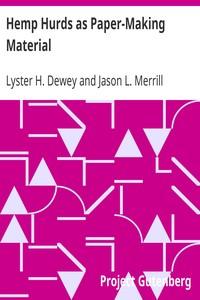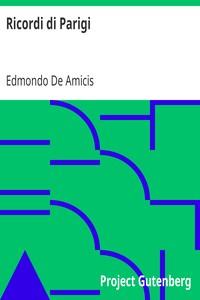|
|
Read this ebook for free! No credit card needed, absolutely nothing to pay.Words: 16562 in 4 pages
This is an ebook sharing website. You can read the uploaded ebooks for free here. No credit cards needed, nothing to pay. If you want to own a digital copy of the ebook, or want to read offline with your favorite ebook-reader, then you can choose to buy and download the ebook.

: Hemp Hurds as Paper-Making Material by Dewey Lyster H Lyster Hoxie Merrill Jason L - Hemp; Fiber plants; Paper industry Technology; Manufacturing@FreeBooksTue 06 Jun, 2023 What hemp hurds are 1 Pith, wood, and fiber 2 Character of hurds affected by retting 2 Proportion of hurds to fiber and yield per acre 3 Hurds available from machine-broken hemp 3 Present uses of hemp hurds 4 Present supplies of hurds available 5 Baling for shipment 5 Cost of baling 5 Summary 6 The manufacture of paper from hemp hurds, by Jason L. Merrill: Introduction 7 Factors justifying an investigation of hemp hurds 8 Character of the material 11 Character of the tests 12 Operations involved in a test 13 Description of tests 16 Comparison of the tests and commercial practice 21 Physical tests of the papers produced 24 Conclusions 25 In preparing the report on the manufacture of paper from hemp hurds it became evident that a short discussion of the agricultural aspects of this material should be included in the publication. Such an article was prepared, therefore, and the two reports are here presented together. The woody inner portion of the hemp stalk, broken into pieces and separated from the fiber in the processes of breaking and scutching, is called hemp hurds. These hurds correspond to shives in flax, but are much coarser and are usually softer in texture. The hemp stalk grown in a broadcast crop for fiber production is from one-eighth to three-eighths of an inch in diameter and from 4 to 10 feet tall. The stalk is hollow, with a cylindrical woody shell, thick near the base, where the stalk is nearly solid, and thinner above, where the hollow is relatively wider. In the process of breaking, the woody cylinder inside of the fiber-bearing bark is broken into pieces one-half of an inch to 3 inches long and usually split into numerous segments. The thicker lower sections are split less than the thin-shelled upper ones, and they are often left quite solid. The inner surface of the hurds usually bears a layer of pith, consisting of thin-walled cells nearly spherical or angular, but not elongated. They are more or less crushed and torn. They are probably of little value for paper, but they constitute less than 1 per cent of the weight of the hurds. The principal weight and bulk consist of slender elongated woody cells. The outer surface is covered with fine secondary fibers composed of slender elongated cells, tougher than those of the wood but finer and shorter than those of the hemp fiber of commerce. No method has been devised thus far which completely separates from the hurds all of the long fiber. From 5 to 15 per cent of the weight of the hurds consists of hemp fiber, in strands from 3 inches to 8 feet in length. Some fragments of the bark, made up of short cubical cells, usually dark in color, cling to the strands of fiber. Nearly all of the hemp in the United States is dew retted. The stalks are spread on the ground in swaths as grain is laid by the cradle. The action of the weather, dew, and rain, aided by bacteria, dissolves and washes out the green coloring matter and most of the gums, leaving only the fibrous bark and the wood. The plants in this process lose about 60 per cent of their green weight, or about 40 per cent of their air-dry weight. The stalks are sometimes set up in shocks to cure before retting, and after retting they are set up in shocks to dry. Each time the stalks are handled they are chucked down on the ground to keep the butts even. In these operations sand and clay are often driven up into the hollow at the base of the stalks, and this dirt, which often clings tenaciously, may constitute all objectionable feature in the use of hemp hurds for paper stock. In Italy and in most localities in Russia and Austria-Hungary where hemp is extensively cultivated, it is retted in water, but water retting has never been practiced in the United States except to a limited extent before the middle of the last century. Hurds from water-retted hemp are cleaner and softer than those from dew-retted hemp. The fiber is sometimes broken from dry hemp stalks without retting. The hurds thus produced contain a small percentage of soluble gums, chiefly of the pectose series. Comparatively little hemp is prepared in this manner in America. Free books android app tbrJar TBR JAR Read Free books online gutenberg More posts by @FreeBooks
: The Sport of the Gods by Dunbar Paul Laurence - Domestic fiction; African American families Fiction; Rural-urban migration United States Fiction@FreeBooksTue 06 Jun, 2023

: Ricordi di Parigi by De Amicis Edmondo - Paris (France) Description and travel; Zola Émile 1840-1902; Hugo Victor 1802-1885 Historical Fiction; IT Viaggi@FreeBooksTue 06 Jun, 2023
|
Terms of Use Stock Market News! © gutenberg.org.in2025 All Rights reserved.






